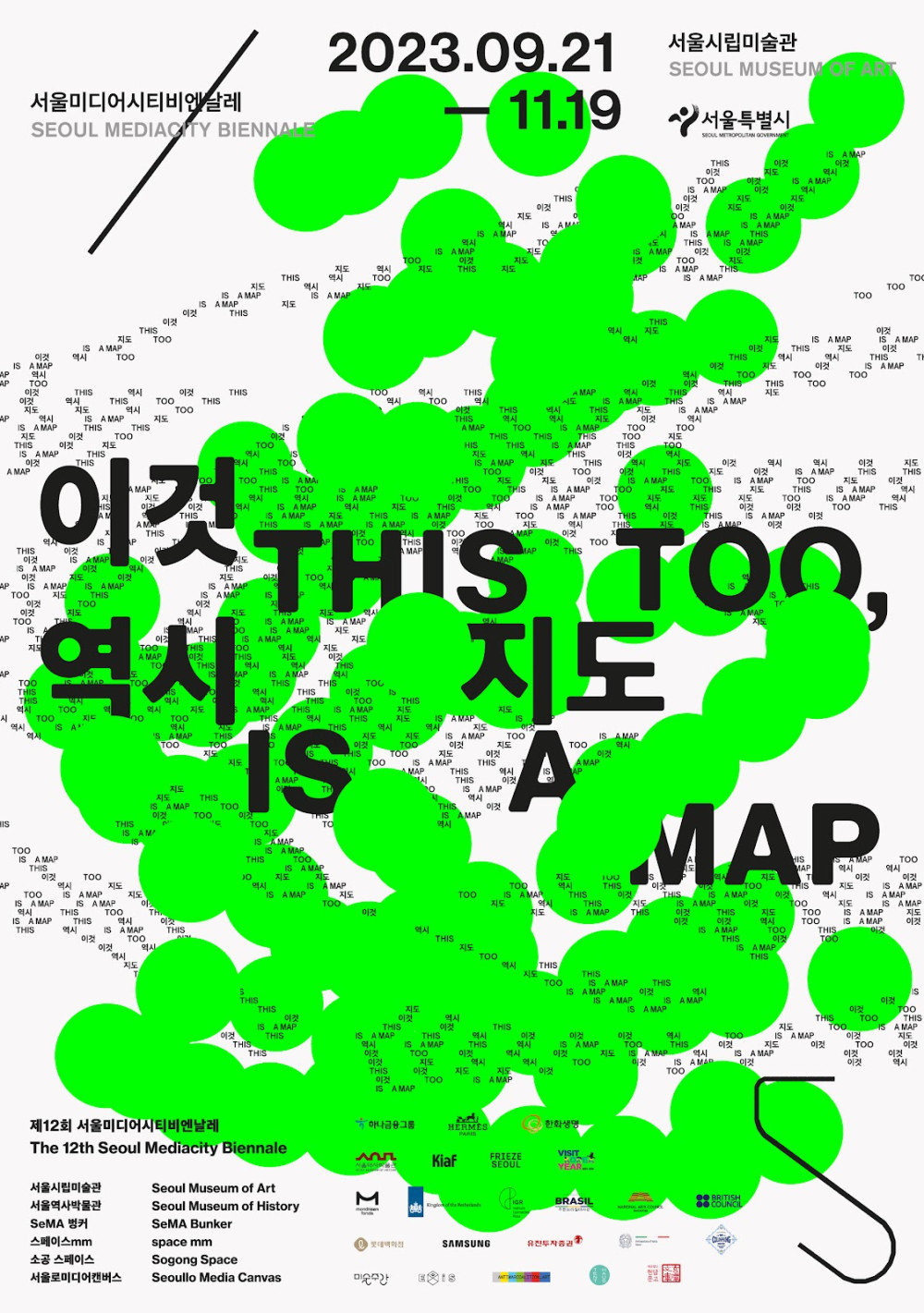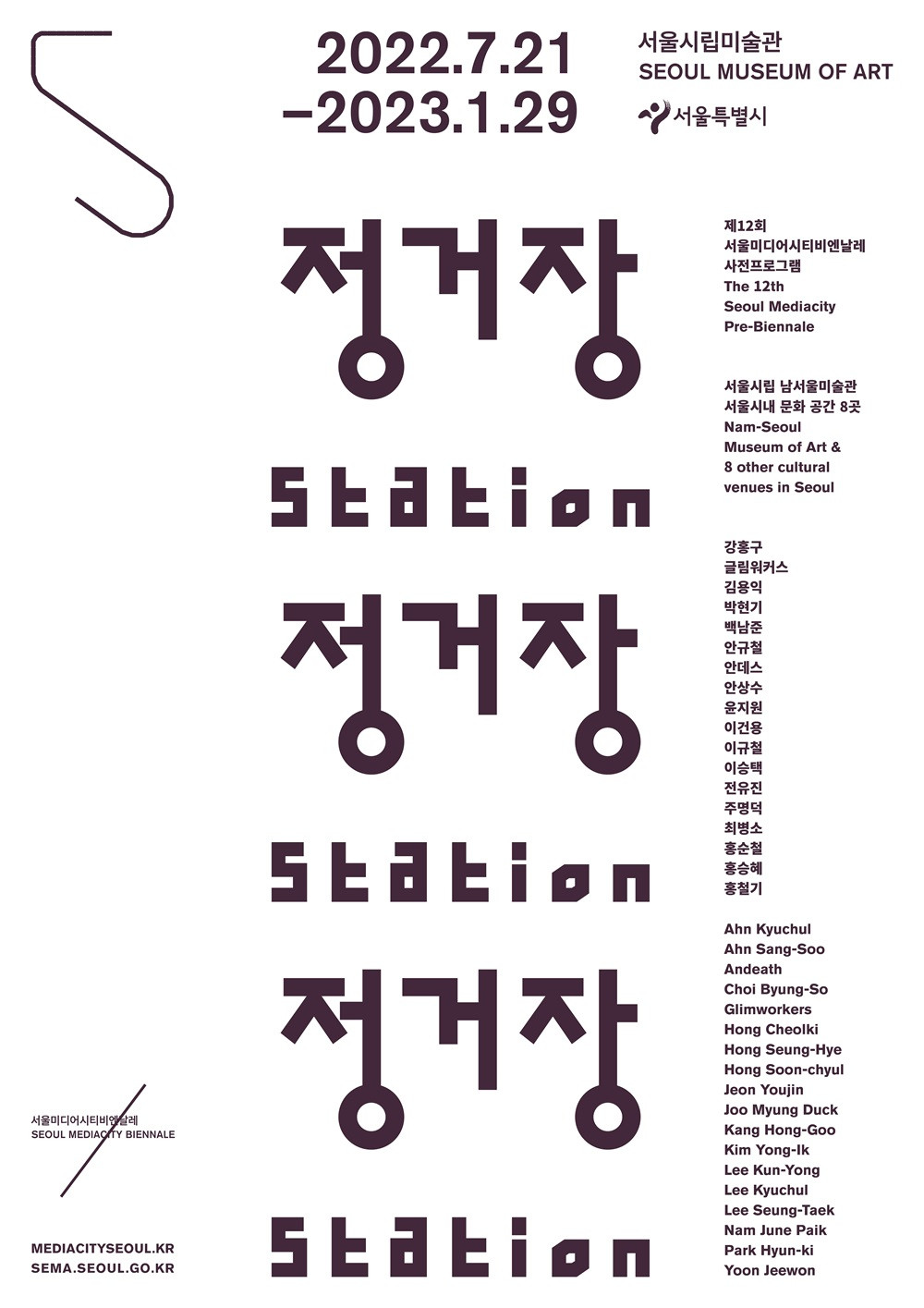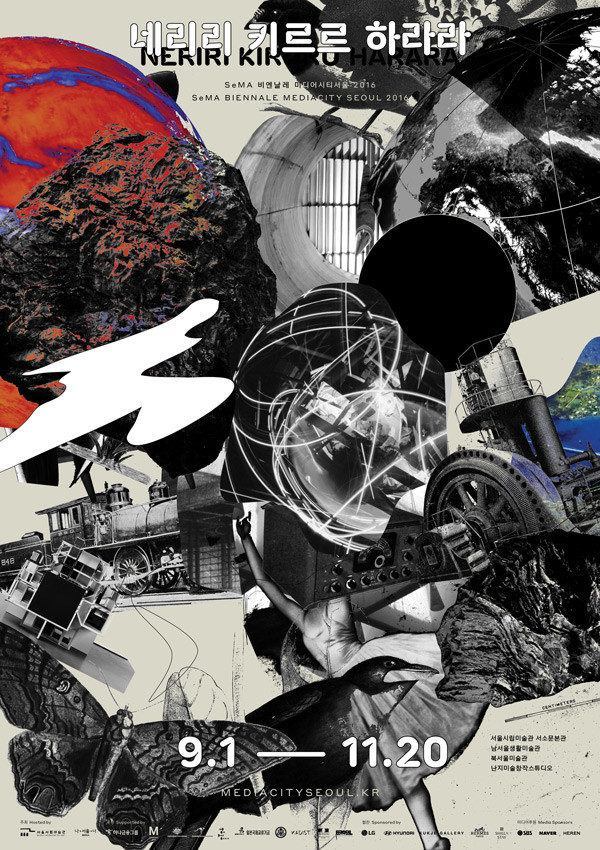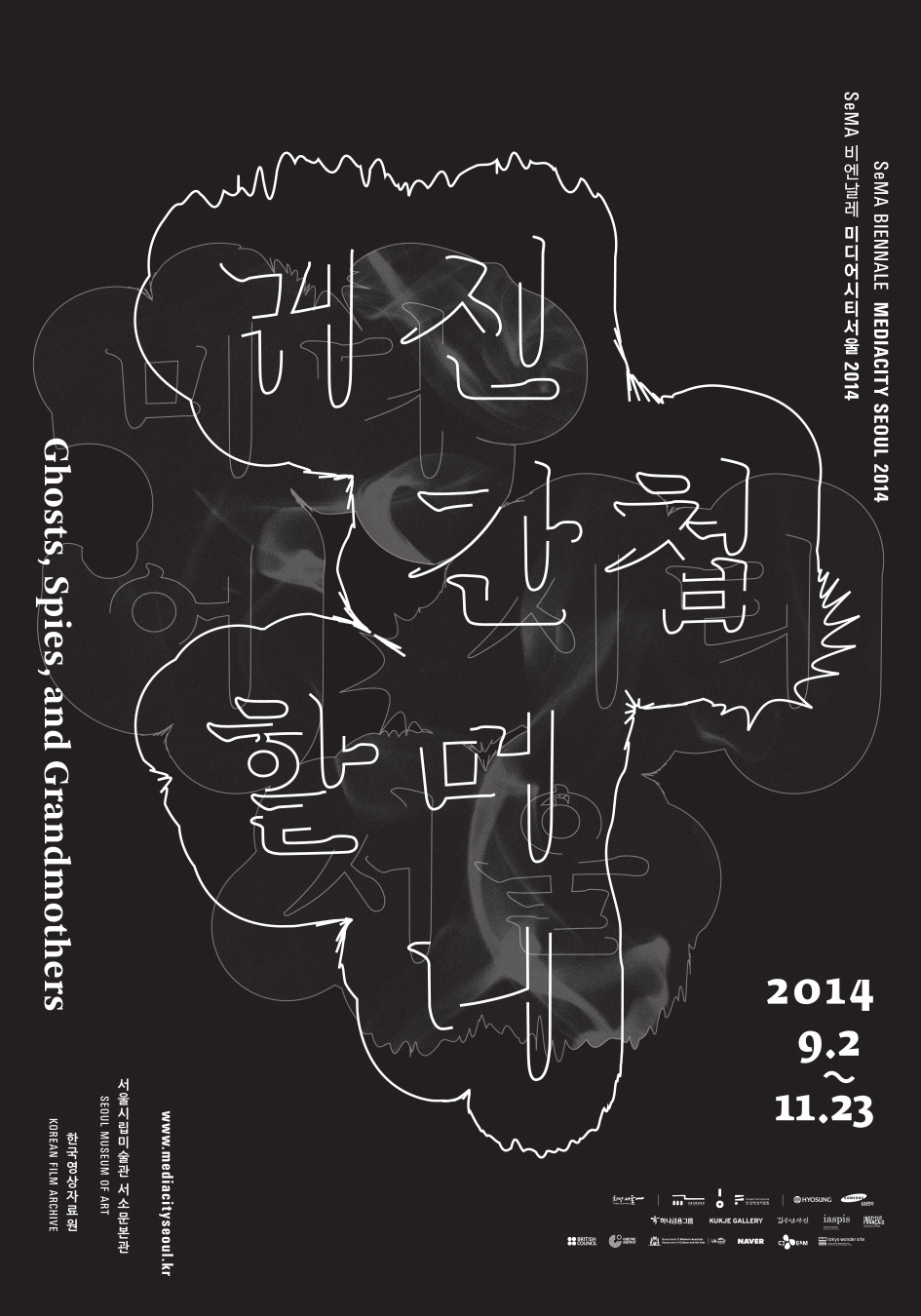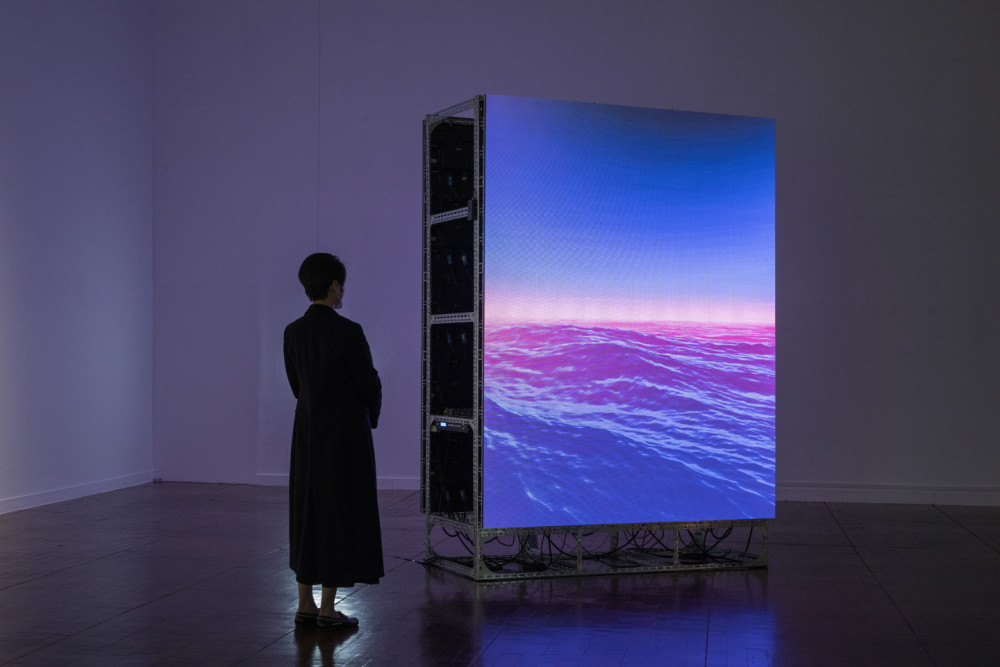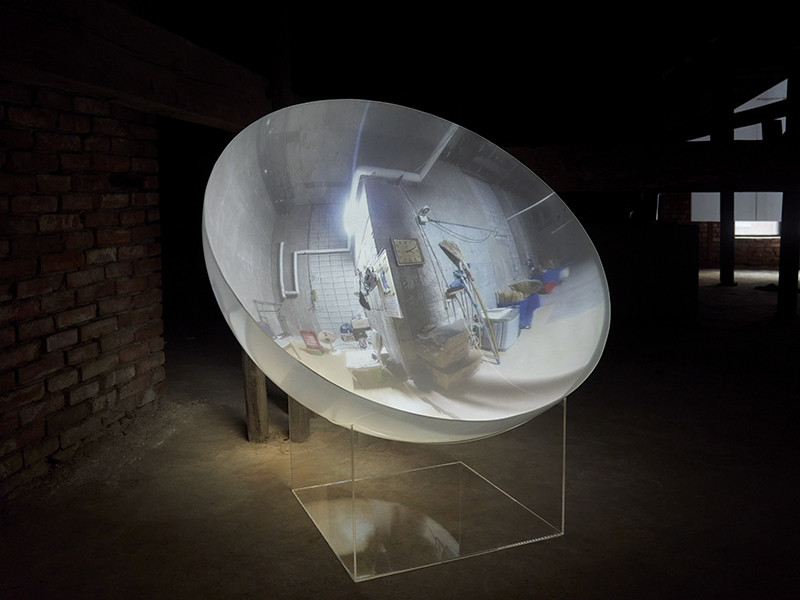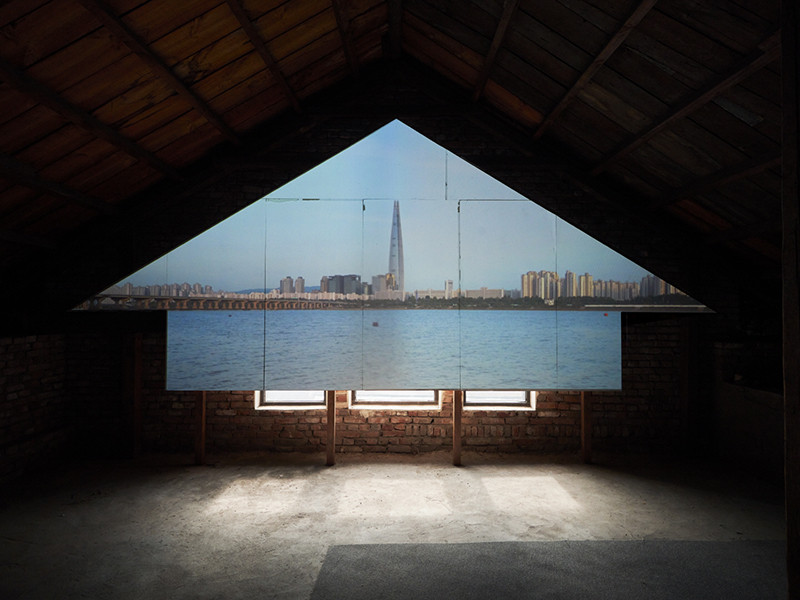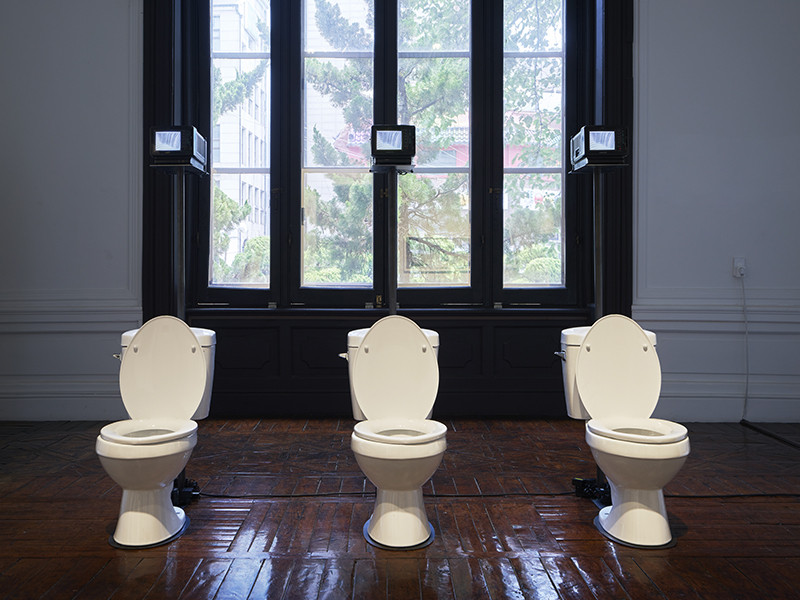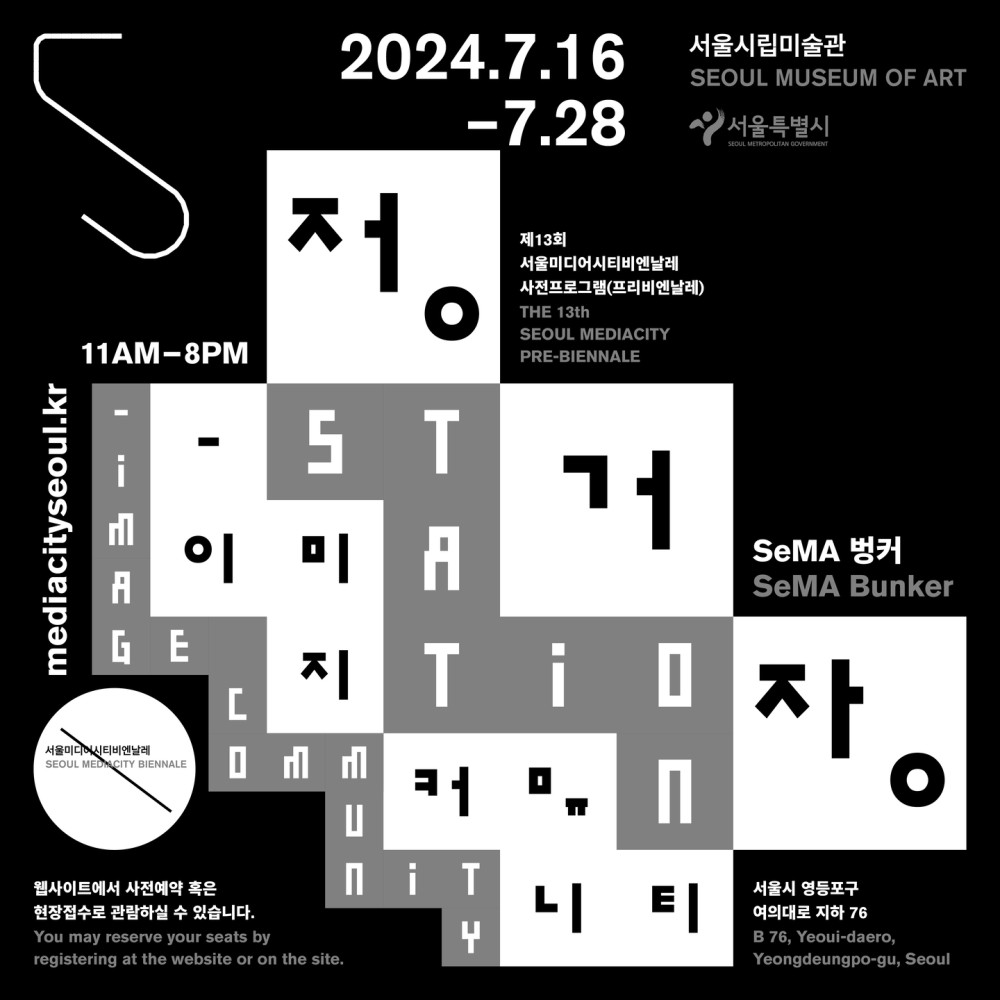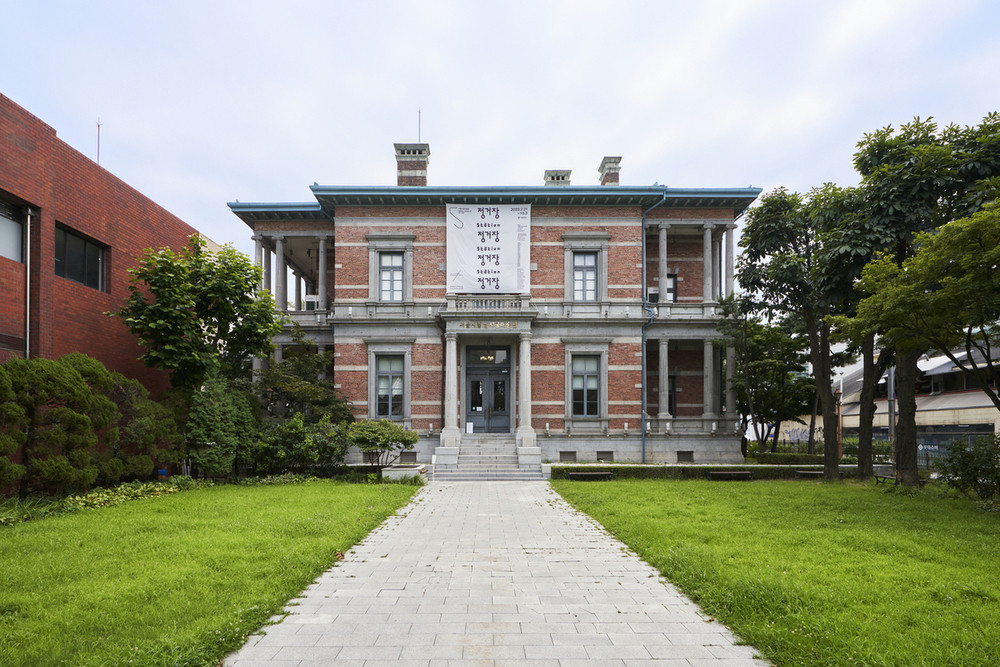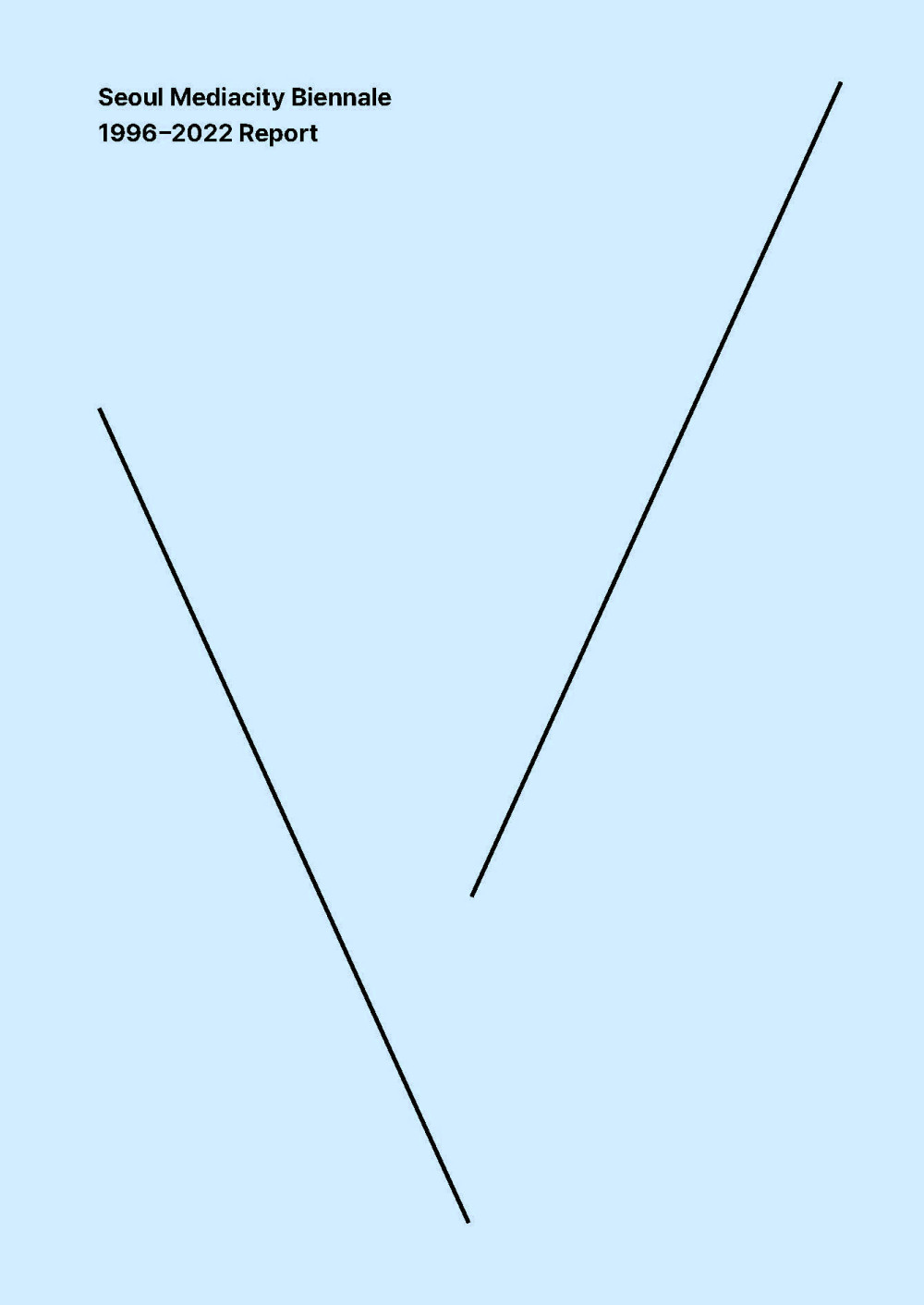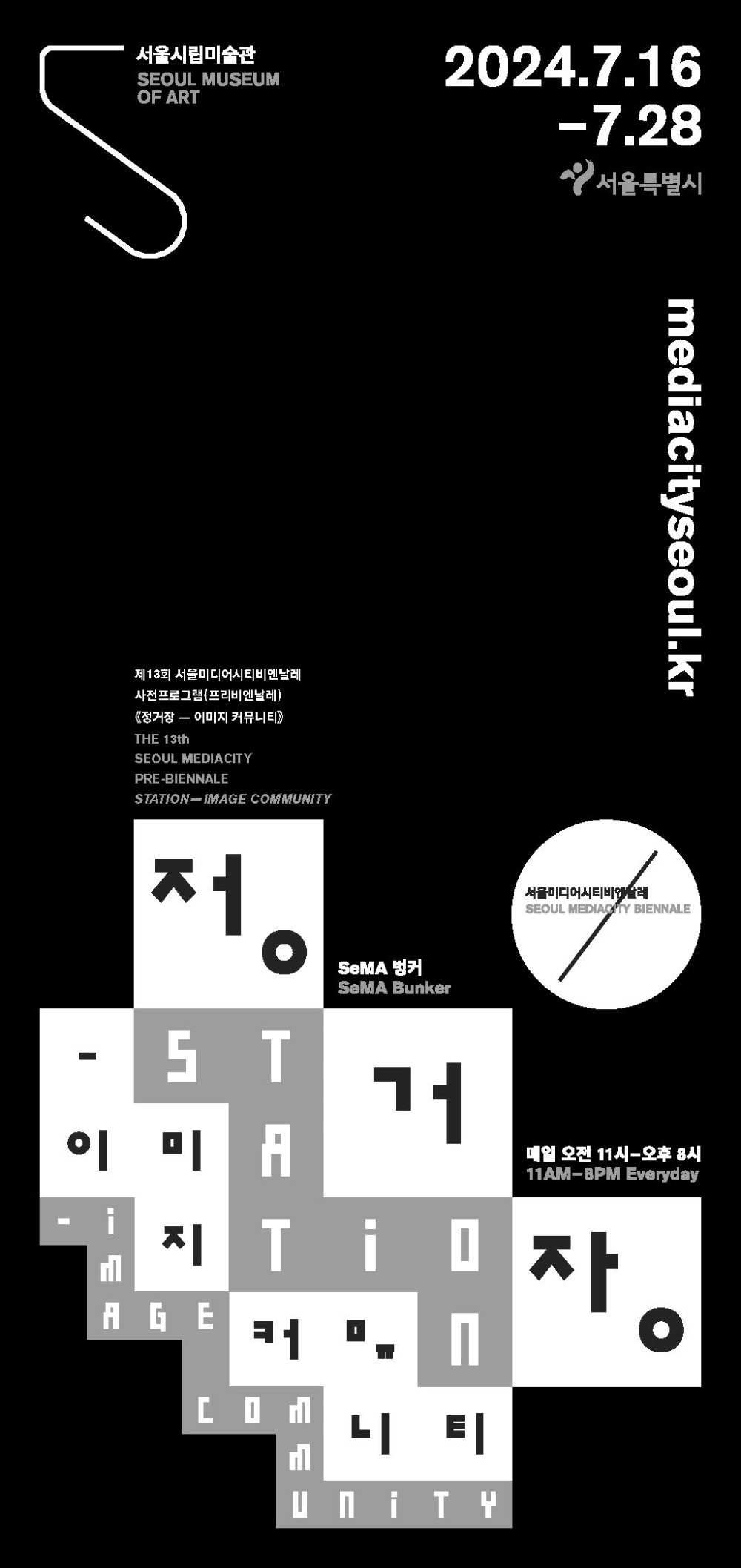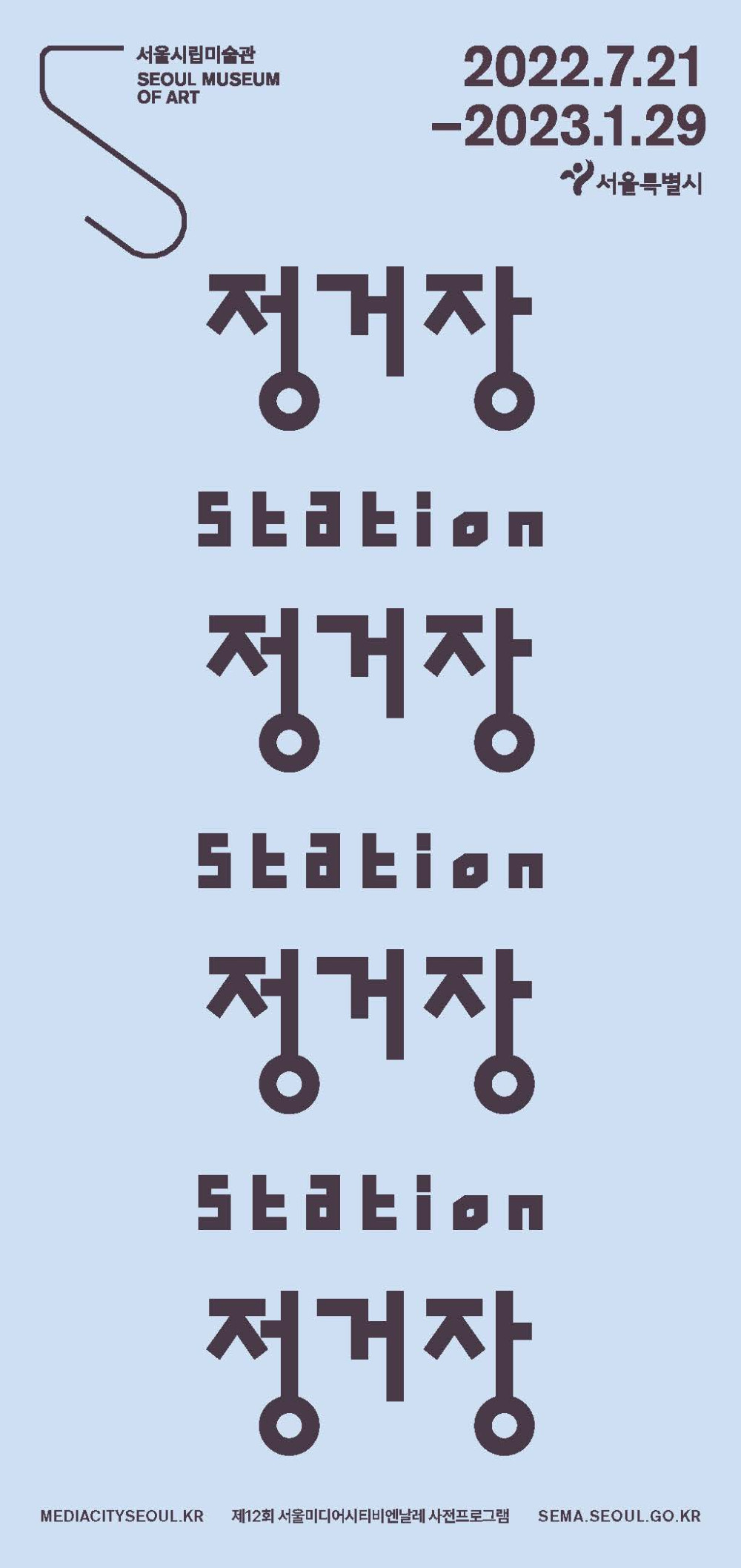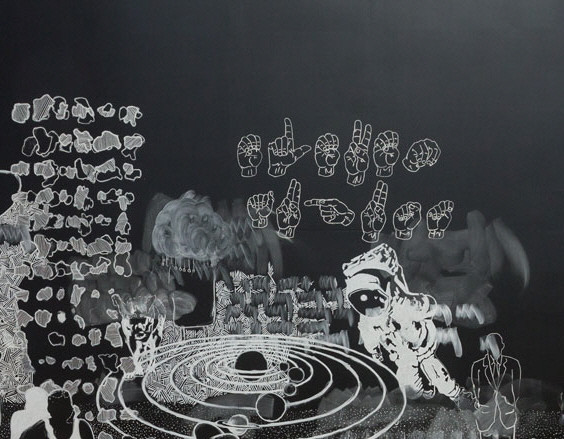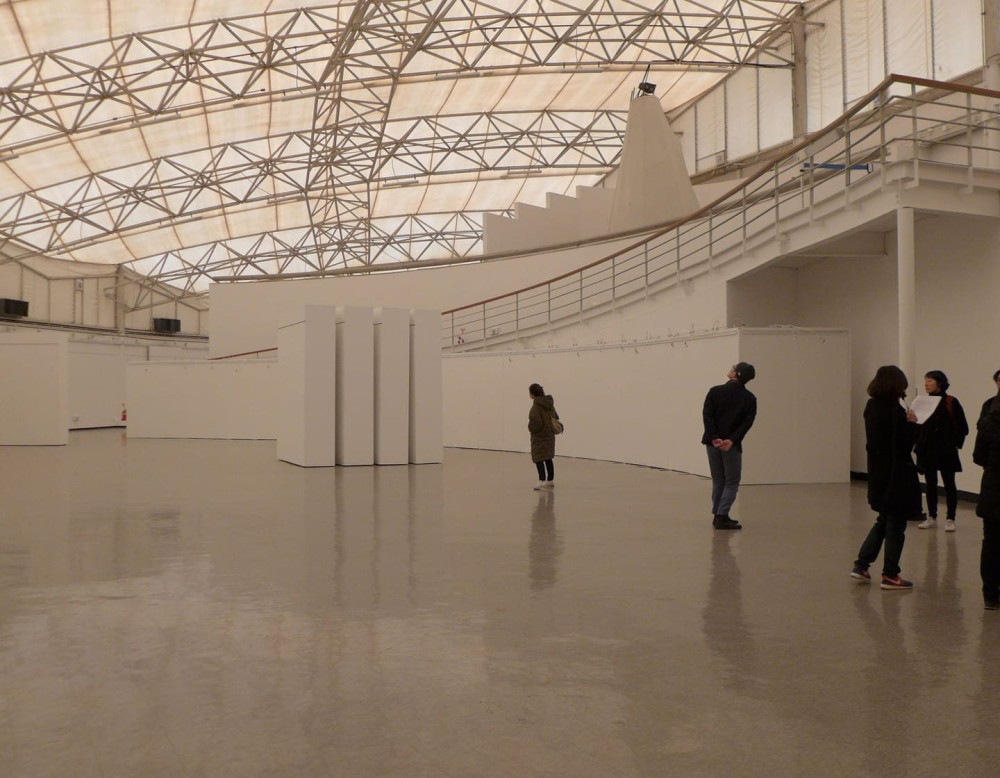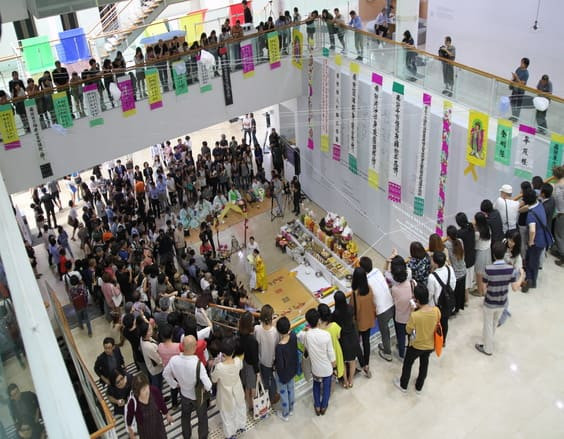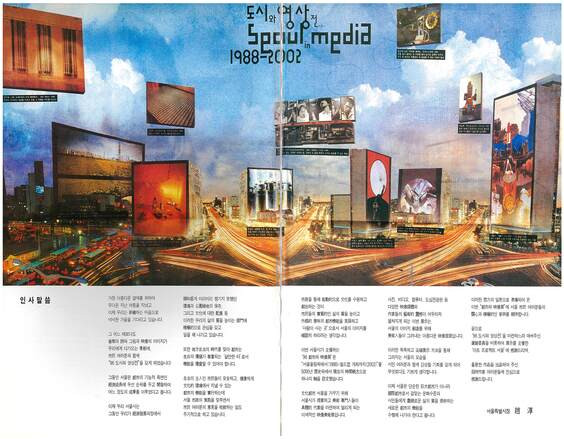Collaborators
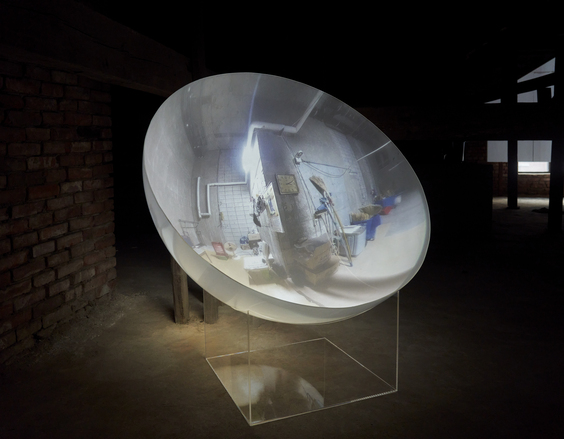
This interview is a conversation with Kim Kyoung-ho, technical director/technician, and Hong Cheolki, who is responsible for on-site photo and video documentation, about the Biennale and collaboration. It is a re-edited version of the interview from the Seoul Mediacity Biennale 1996-2022 Report, published in 2022, with the addition of relevant images from 2024.
Kim Kyoung-ho was a technician for the 8th and 9th editions of SeMA Biennale Mediacity Seoul (2014, 2016), as well as serving as technical director for the 11th and 12th Seoul Mediacity pre-Biennale (2021, 2022). His solo exhibitions include Magic Bullet Broadcasting Network (Art Space Pool, 2013) and Oceanic Affection (Sansumunhwa, 2016). Since 2014, his work as a technical director has been integral to numerous art organizations and projects, leading him to establish the media exhibition production company Manriart Makers in 2017. https://manriart.com/
Hong Cheolki provided photo and video recording services for SeMA Biennale Mediacity Seoul 2016 as well as the 10th, 11th and 12th editions of the Biennale (2018, 2021, 2023). He also participated as a writer for the 12th pre-Biennale program. Since beginning to document art events in 2012, he has carried out personal projects in which he records interesting aspects of the city and its surrounding environment. His solo exhibitions include No Man’s Land (Hapjungjigu, 2015) and Near Hear (Show and Tell, 2020).
Research Title Collaborators
Category Interview
Edition The 12th Seoul Mediacity pre-Biennale
Participants Kim Kyoung-ho, Hong Cheolki, Seoul Mediacity Biennale Office
Korean-English Translator Barun
English Copyediting Andy St. Louis
SMB You each participated in the Biennale four times between 2014 to 2021 as technical director and photographer, respectively excluding the 10th edition for Mr. Kim. Of the many professionals needed to successfully mount a biennial exhibition, these roles are particularly important. As collaborators in the Biennale, one of you was responsible for the technical coordination and operation of the artworks, while the other was responsible for visually documenting the Biennale presentation. Mr. Kim, could you talk about your background and how you came to work on the Biennale?
KIM KYOUNG-HO (KIM) After having majored in photography while at university, I worked at the Korean Academy of Film Arts for two years, beginning in 2006, where I was responsible for the data converted from analog to digital as well as the digital data processing. It was transitional period for film making, which at that time was moving from analog to digital, so most existing educational institutions faced difficulties in systematically teaching the technical elements, sometimes equipment was abandoned, or there wasn’t proper manual. I was able to learn these things while working as a technical assistant at the film school and making use of its abroad range of equipment and information. I had to meticulously study the system of video signals because if I couldn’t understand the flow of data precisely, then problems would inevitably arise, such as frames being pushed out of place or sounds not syncing. One of my projects was to organize a study group in order to translate references materials in English, which was ongoing for about two years. Now that I think about it, all of these things built up my basic physical strength. Around 2011, artists began asking me about problems they encountered, such as lines or blocks on the screen or distorted frames, so I started consulting for them. In Spring 2014, I participated as a technician for the exhibition Total Recall at Ilmin Museum of Art, and shortly after that I was invited to assist on the Biennale in 2014.
SMB What types of changes in equipment and technology did you experience in your work and exhibition production environments, beginning in 2008 and for the subsequent five years?
KIM When I first started working at the film school, film was still the dominant medium. HD camcorders became available around 2006, so people started using high-definition equipment in the indie film scene around that time. However, analog equipment was still widely used until the early 2010s. Film images had to be digitalized for postproduction before ultimately being converted back into film again. The process was fundamentally fraught with problems compared to now, when the entire workflow including postproduction and screening is done completely digitally. Back then, even small mistakes in the audiovisual data could result in problems with image resolution or quality. Not to mention, very few institutions specialized in actually teaching these technical details. It was the same situation at the film school in fact, film directors and directors of photography who had worked in Hollywood used to personally pass on the practical lessons they had learned through the Internet or special lectures, like peddlers. This meant that people were limited to learning fragments of information rather than acquiring systematic knowledge. I guess the film school might have been slightly better… Before the digital age, technology was constantly changing and there were numerous variants of the technologies in use. It would be fair to say that video works created at this time were produced through individuals’ understanding of the tricks of these variants. In any case, digital technology reached a turning point amid those numerous attempts, which immediately led to the next era.
During the transition period from film tape to digital memory, many artists had a trouble trying to transfer tape sources to their computer hard drives. As for myself, I needed work in order to be able to continue my own art activities, so I ended up making a living by filming and providing technical support for foreign news broadcasts.
SMB Your solo exhibition Magic Bullet Broadcasting Network was held at Art Space Pool in 2013. The exhibition was centered around the news that you experienced while working as a technical director for an Iranian cable news broadcasting company in Seoul, as well as other ideas regarding images reproduction and “imaginative culture” in new media environments. At the time, you were also working on digital archiving at institutions such as the National Museum of Korea and the Asia Culture Center, Gwangju. Despite a lack of professional human resources or other systems designed to handle the changing technological environment of the art world, you seem to have filled this gap as an individual with expert knowledge. I think you must have given some thought to pursuing technical directing for exhibition as a career trajectory.
KIM I was lucky because my father ran a photo studio. When I was a child, I would follow him into the dark room and I always wondered, “How does light become an image?” Later on, I majored in photography and imaging in university and learned about things that I had previously only imagined. In doing so I think I played a sort of game… of constantly imagining what happens behind the visual image data that I see in front of my eyes. And as got more involved art, I also became more curious about how “intact” data underwent transformation.
At first, I thought about “intact” data in a technical sense, but as I slowly gained experience, I also began to question it in a semantic sense. I used to put a lot of effort into creating detailed expressions or reproductions of what I imagined, accumulating experiences of the same processes through several distinct work experiences, until I naturally developed the ability to adapt to various types of media or environments. In other words, I began to materialize and question everything that I imagined. For an art work whose sole material is media, the artist’s intent is essentially realized through technical equipment, which constitutes the last piece of the puzzle in the production process. But I have learned through experience that if the person in charge of intermediate work, such as myself, cannot understand the intent, flow, or processing of the artwork, it cannot be properly shown. For this reason, I nurtured a desire to minimize any potential damage to the meaning of a given work by interpreting the artist’s intentions, making certain connections, and reducing foreseeable errors. In the face of the various limitations that exist in reality, I always sought to make the best of what was possible.
SMB Those personal interests and activities became official for the first time in the exhibition at Ilmin Museum of Art, right?
KIM I participated in that exhibition being reached by buup whom first joined for the spatial design of the exhibition. Then, I was called by the Biennale in 2014 right after that, which became my first official task with overseeing the technical part of the whole exhibition, not only in terms of technical expertise but also operational know-hows. I love doing structural planning such as creating workflows. Of course, for large-scale exhibitions it is essential to observe the flow of the exhibition as a whole rather than prioritizing individual works.
SMB Knowledgeable experts with specialized backgrounds such as yourself are critical for producing media art exhibitions, which encompass a multitude of variables. It should also be noted, however, that some general equipment companies also lease and install technical equipment. What do you consider the competitive edge of a company like Manriart Makers?
KIM Around the end of 2014, I began working at an artist cooperative and over the next three years I often thought about sustainable creative structures. It is so difficult to make a decent living while working alone. On top of that, my work requires a lot of capital, so it’s essential that I continuously accept and undertake new commissions. Due to these conditions, I became interested in creating a collaborative enterprise with other artists as a means of mutual survival. After giving it a lot of thought, I initially devised a private business, but through my experiences with the cooperative, I realized that having a simple, nominal group called a cooperative doesn’t necessarily solve the problems of survival in today’s art world. I did almost everything possible during those three years, devoting as much energy toward my work with the cooperative as I did toward my own practices as I attempted to cultivate both a community and a sustainable environment, but in the end I concluded that a cooperative wasn’t straightforward solution.
While working on the Korean Pavillion at the Venice Biennale in 2019, I became familiar to with German media company called EIDOTECH that would become a key reference for Manriart Makers. In fact, EIDOTECH’s structure is not much different from Manriart Makers, as a social enterprise whose members are active artists that agree on certain standards with respect to working conditions and wages that I think are ideal. We gained confidence in our work by holding onto the belief that if we could participate in meaningful exhibitions while realizing these standards, we would not only be more competitive but also capable of delivering much better results for the art events that we produce. In Germany and elsewhere in Europe, teams like ours work almost four times more slowly than we do and still command high fees. However, other than core personnel, their workforce primarily consists of freelancers including internationally active artists, and they have fixed systems in place, so that their in-house team runs its own training programs. We also began a training program last year, and gave small tool sets as gifts to new members that joined the team.
SMB That’s wonderful. It seems that Manriart Makers doesn’t simply aim to generate revenue, but also seeks to organize a team that is capable of providing the technical support necessary to accompany exhibitions and art productions. It’s a team, as well as a community comprised of artists who create sources of income together, while simultaneously providing an educational platform in order to keep up with the changing media environment, all with in a highly ideal structure.
KIM Yes, but I need to keep doing research, too. Technology changes extremely quickly, and artists don’t always have time to figure everything out by themselves. At a certain point, everyone gets stuck or encounters a situation that they don’t know how to deal with. That’s why I want to create a virtuous cycle-and ecosystem with the basic conditions for creating good results, distributing them effectively, and making it possible for everyone involved in the production process to earn a living, even if the revenue is relatively modest. You previously mentioned the lack of institutional systems for keeping up with emerging technologies but realistically speaking, I think it is difficult for any institution to operate according to a perfect structure that is capable of responding to every single technical change. Nevertheless, I do think that it would be nice if there were a connection point through which external teams could meet and learn from each other, while creating a culture of playing, learning and creating together. Actually, these things aren’t easy to achieve within the entrenched organizational structure of an art museum, but without such measures it becomes increasingly difficult to adapt to ever-changing artistic trends or circumstances.
SMB What is the biggest difficulty in running a business, based on your experience?
KIM The continuity of work. There were many instances in which we prepared for a range of outcomes that would enhance our skills, but we ultimately had nowhere to use them. Compared to EIDOTECH, which works all over Europe, we are much more geographically limited. Even if we were to consider working abroad, we would primarily be looking to China or Southeast Asia, however, China already has a high level of technology based on huge capital investment, while Southeast Asia is led by a small number of elites boasting Western educations. In the current market, we are anxious that a company like ours may quickly reach the maximum limit of our ability to compete by lowering returns. Another issue is that current market structures make it difficult to compete with purely commercial companies, even though there also ought to be interesting things to keep working on with colleagues. We obviously seek to generate a profit as well, but it’s not easy to keep up with the mindset of commercial companies. Their calculations are accurate, fast, and extremely efficient, which makes their attitudes quite different from companies like ours, which tends to use more energy than needed. In my opinion, it’s not easy to compete. That said, there are also some companies that specialize in media exhibitions while constantly striving to produce good results, but still believe that the most important and most difficult aspect of all is that of creating and maintaining an art community.
SMB What did you feel was the most rewarding part of your work on the past Biennale?
KIM Anytime we take on an exhibition and set about to working on it in earnest, we first hold internal screenings and undertake a process of pre-visualizing the works and the exhibition. We run simulations in our heads, create concrete mental images, and imagine what the whole exhibition will eventually look like. For the 11th edition, the ideas that we generated during this stage ended up matching the actual results quite closely, and I could sense that we were getting better at doing this kind of work. Regarding field responsiveness, Yuri Pattison’s sun_set pro_vision (2020-21) from the 11th edition comes to mind. The manual for that work arrived in advance, and although clearly understood how the piece was supposed to work by materializing images through a game engine called Unity, it was extremely difficult to connect it to the LED panel on site.
Media works have a lot of variables that need to be considered whenever the exhibition environment changes—such as connecting new equipment— and it’s impossible to predict all possible scenarios for each case. We really struggled to bring Pattison’s work to life. While in retrospect it might be seen as a simple problem, it was difficult to figure out how to connect to a new panel while preserving the original without interfering with the principle of the work, but we eventually found a solution to the problem, thankfully. Throughout this process, we were forced to consider such details from the point of view of an artist who is in control of the media. In fact, the scope of the task technically expanded from exhibition production to art production. When I think back on the 11th Biennale, I believe it was a well-balanced exhibition in which all the necessary elements were in place without emphasizing media itself. We prepared for the project by paying close attention to the details in order to conform to the artistic director’s intentions. We considered the overall budget and looked for ways to enhance the image quality in some works while selecting low-performance speakers and adjusting volumes according to the spatial situations for others. All these things were possible as a result of our process of imagining the overall image of the exhibition during the preparatory screening stage.
SMB How did you first begin working the Biennale, Mr. Hong?
HONG CHEOLKI (HONG) Before we begin, there’s something that I would like to say. I feel that my relationship with the Biennale was more as a non-expert or audience member than an expert or an artist, especially when compared to the other people you have interviewed so far.
SMB You’re from a different generation as well.
HONG Of course. And I also began my career without having received any institutional art education. To tell the truth, I only ended up here thanks to the people that I met through pursuing my interests, which inspired me to continue to search for interesting things within those relationships. That’s why what I say or my perspectives, judgments, attitudes, standards, etc. might be slightly different from other people in the art system. On the other hand, I think that also might be my charm. (LAUGHS) I try to maintain a sense of non-typicality but perhaps it’s not as easy discuss the system of art biennials from an expert point of view. Anyway, I wanted to explain my position first.
I first started working on art in 2008. I worked as a local coordinator for ŠKART, a Serbian art collective that had been invited to the Seoul Design Olympiad, even though I didn’t know much about the artists or the event itself. It was sort of a part-time job that I was offered and I had no reason to turn it down because, at that time, I just tried to learn from everything that I experienced. Among many things that I did while accompanying ŠKART in Korea was recording their activities by taking photographs.
SMB What kind of work does ŠKART create?
HONG Various things. It was a long time ago, so my memory is a little hazy, but they essentially adopt a performative format to engage with social issues or other major stories in public spaces. For example, they form temporary communities like a communal embroidery project or a choir.
SMB Would it be accurate to say that your photography career began during this period of recording their co-production processes?
HONG Sure. I’ve been asked to photograph various exhibitions over the years since then. But for me, photographing exhibitions somehow feels more like a learning process than a job. Because I never received a formal art education, I felt that I needed to study in order to be able to talk and interact with artists, but reading a text in the corner of a room or listening to someone’s lecture wasn’t for me… To begin with, the very act of seeing an exhibition was extremely helpful, and documenting it in photos was like seeing the exhibition one more time. I documented several artists’ exhibitions before being commissioned to do the same for the 4th Anyang Public Art Project (APAP). It must have been in 2013, right?
SMB The 4th APAP was held from 2012 to 2014.
HONG That was the first time that I documented a large-scale art event- it was this opportunity that led me to where I am today. It should be noted, however, that I was able to continue working not because of my abilities, but because the people around me thought highly of me. In any case, APAP was definitely a turning point.
SMB In what ways was it a turning point for you?
HONG It was the first time that I experienced an exhibition from start to finish. APAP was executed on quite a large scale and was organized by an institution, the Anyang Arts Foundation, two factors that differed from the exhibitions that I had previously documented. The subject of a photographic record can take many forms, and since APAP is both a triennial exhibition and a public art project, it necessarily includes a large variety of programs. Recording each program in detail allowed me to experience and engage with all genres of photography; shooting the exhibition spaces, public programs, indoor and outdoor activities, studio photo and making photos. There were also quite a few media arts.
SMB Another notable feature of the 4th APAP was its attempt to convert various types of media arts, which conformed to the paradigm of immaterial art, into commonly shared resources.
HONG That’s right. I think that encountering and documenting various works and projects at the 4th APAP naturally led to my participation in the Biennale later. That’s why it was an important turning point for me.
SMB You previously described yourself as a non-expert, yet you have been developing your own photographic practice since your debut solo exhibition No Man’s Land at Hapjungjigu in 2015. Could you talk about the differences between taking photos as artworks versus as forms of documentation?
HONG What I want to show through my practice are different ways of seeing spaces, for instance, points of perspective, attitudes, and even world views. No Man’s Land dealt with triviality surrounding landscapes. To be more specific, the photos depict “non-existent landscapes” that are actually real but are typically ignored, and thus are only found beyond the scope of general interest.
SMB Would you say that you make invisible beings visible by taking photos of them?
HONG In a sense, yes, but the word visible is also limited. These spaces are visible, but perhaps they are just unseen… Anyway, if we assume this as the concept behind my work, the exhibition space may then be seen as having the opposite nature, a space that is perfectly visible and has a clear purpose of display – in terms of the “visibility” aspect, at least. However, that point ultimately intersects with the intrinsic question of photography. Even though this may concern all visual media, from a conceptual point of view, it is actually closer to the “photography.” Anything related to the form or formality of an exhibition is not the object of an idea. Rather, it is an absolute object, and this is why taking photos of artworks, exhibitions, and art activities gives me a different kind of satisfaction; they are the opposite of my personal interests. While it may seem trivial, making judgments while photographing, such as deciding whether a certain corner will fit in the frame or not, makes me happy. So this work is a greater source of joy for me than it is a source of income.
SMB To continue on that topic, you mentioned that the act of photographing involves a process of various determinations; selecting a subject, determining the frame, and retouching the image for its intended use. We have already talked about the 4th APAP, but there are certainly other diverse objects that photos can document in the Biennale. Exhibitions may contain video works, sculptures, paintings, installations, and a variety of accompanying programs. There may be talks or lectures with simple movements, programs with dynamic movements, outdoor productions in varied circumstances, and so on. Every moment in this series of processes or situations requires some type of judgment. What are your primary criteria for judgment?
HONG Objectivity seems to be the main difference between documenting an exhibition or program and pursuing my personal photographic work. It is always important to adopt certain frames that clearly reveal an exhibition’s characteristic or visual composition to a wide range of viewers. I think it’s also important to configure the relationships among all the data that can be found within the rectangular frame of a photo. I’m not sure how objective I can truly be, but another way to talk about this objectivity might with regard to a type of “frontality.” We have all experienced having identification photos taken. Everything has a front view, but in the case of exhibition records, I think that the most important thing to consider is how to determine and reveal a kind of social front. This may be very personal, but I feel it’s still quite difficult for me to determine such frames. In my latest solo exhibition, I spent time contemplating these issues and even tried photographing and presenting a 360-degree view of a space. (LAUGHS) Anyway, framing is very difficult.
SMB I also understand that what’s framed on photography equals to the artistic statement. Would you say that it’s important to approach the act of framing by knowing which side is the front?
HONG Yes, I think that’s important to me because it’s like taking an identification photo for an exhibition. I want all the information in the frame to be clear and balanced.
SMB To tell the truth, I like your photographs because they create certain distance and delicate tone which don’t exaggerate or distort information. I’m sure there are other possible paths toward creating exaggeration out of multiple options; on the other hand, not making such a choice may be seen as a virtue.
HONG That’s true. But it may also be that I’m simply unable to make that choice due to technical shortcomings. (LAUGHS) I think it’s important to contemplate what is determined through the final retouching process. I try to edit images so that they are as close as possible to what can be seen with the naked eyes. Until recently, I held the attitude that retouching any photo documentation of exhibitions would make the images false in some way. For example, I felt that the seemingly perfect result of using Photoshop to alter photos of the SeMA so that its spaces would appear level and plumb was not real.
But now I’ve changed a little. In light of the changing media environments that we all face, I thought that perhaps such retouched images might be capable of transcending reality somehow. I’m still thinking about how to deal with this change, though, and I’m trying to adopt a slightly different point of view, rather than simply taking a negative perspective. Anyway, I think the Biennale itself reveals my attitude insofar as experiencing and facing these changes. It has always guided for various definitions and forms of media art, and I think it should continue to do so.
SMB Considering that you both began doing related work in earnest in the mid-2010s, you must have seen and experienced various types of exhibitions centered around Seoul in addition to the Biennale. How would you describe the characteristics of this Biennale?
KIM Based on my own experience, I think the biggest distinction is the Biennale’s fundamental consensus and its attempt to overcome the limitations of contemporary media.
SMB When you say media, are you referring to it in a more technical sense here?
KIM It would be more appropriate to say that the Biennale goes beyond the fundamental definition of media. In fact, I think that technical limitations can be used differently, like a type of “stone axe.” Unlike general exhibitions, biennials often constitute highly political acts, and in some situations they also opt for glamour to create social meaning or influence. However, this Biennale has displayed an adamant attitude that manifests as an effort to resist conforming to general attributes. Aside from the issues surrounding the use of cutting-edge technology, it is possible to infer such concerns and look into the past and the future by using old technology. I guess it’s not easy to express it in words. Other biennials are very intense at first glance, but this Biennale actually presents itself as a journey toward deconstructing such typicality.
SMB Whenever people talk about media art, they tend to imagine works that superficially incorporate technological changes, but the Biennale cannot be understood solely from that angle. Meanwhile, in a long-running historical context, technology and art have simultaneously progressed to their present levels by constantly influencing each other. How would you define today’s media art?
KIM Rather than defining it, I think it is important to identify the easiest trap for so-called media art to fall into, which is thinking about how it can surpass an experience like PlayStation. (LAUGHS) Art cannot compete in the same way as gaming platform, which allows for a high degree of user freedom and a wide range of visual implementations. Today, many media artworks are constructed in the form of games. If we only focus on the flamboyant aspects of media, it will become impossible to avoid being addicted to such types of methodical implementation. Even if a work’s form is based on its meaning, and even if something capable of transcending technical limitations is generated, the biggest challenge for art seems to be in its capacity to locate meaning. Nevertheless, I think that media art demonstrates the meaning or direction that new media presents in society, while rendering the effects of technology irrelevant. This is the perspective through which the Biennale has operated. In addition, I think that the most promising technologies in media art nowadays are AI algorithms and social networks because they have the power to disturb existing meanings and have a huge impact on modern society. I believe that media art is fundamentally a practice of observing or recording how technology changes our society, whether it be rocks, trees, computers, or VR.
SMB What suggestions do you have for the future of the Biennale?
KIM I hope that it won’t diverge from its current direction. I would like the Biennale to continue its mission of expanding artistic experimentation and meaning, no matter how much attention other potential objectives may elicit nor how more glamorous they may appear. Attempts have been made to always be one step ahead, even this is accompanied by certain risks, and I think this attitude ought to be perpetuated.
Although the Biennale has done a good job in this regard, the meanings that have accumulated over the years ought to be conveyed with greater richness, with the aim of improving access to existing data from the outside, such as an easier means of accessing materials and information from past exhibitions. Perhaps, instead of closing everything once the exhibition is over, a new event could be created to encourage people to discuss previous exhibitions or works. This is an idea that came to me while participating in the creative project at the Asia Culture Center. I know that might be difficult nowadays due to COVID-19, but it would be nice to have people in Korea, especially art students, participate in art productions for creative experience, rather than simply providing budgets to artists. This would create opportunities for collaboration between domestic artists and students, while having a broader impact than merely importing expensive artworks. I believe this type of experience has the potential to yield more meaning than simply presenting a stand-alone exhibition.
HONG I would like to speak to this point as an audience member rather than an artist. To me, the Biennale is fun precisely because it is difficult. The act of recording an exhibition is similar to that of studying art – viewing and photographing an exhibition is interviewed with modes of evaluating the exhibition, so there is no choice but to study. Since the Biennale is an exhibition that deals with media at the leading edge of contemporary art, there are times when I feel only a vague understanding of the works on view, based on information gleaned from texts displayed in the exhibition space or a docent’s explanation. For some exhibitions, it’s difficult to attempt any sort of evaluation. (LAUGHS) Unlike classical art, contemporary art is difficult to understand without continuously studying it or engaging with it, so I sympathize with people who complain about its difficulty. Nevertheless, I think this is what distinguishes the Biennale. I also think that the Biennales that I experienced tended to emphasize communication and interaction with the audience. In particular, the SeMA Biennale Mediacity Seoul 2016 NERIRI KIRURU HARARA involved various devices that allowed people to approach difficult contemporary art. However, I don’t believe that this was a particularly enlightening measure.
SMB Do you mean that there were various channels for participation and experience, which relied on the curiosity of audience members and their willingness to participate?
HONG That’s right. I would like those channels to be strengthened and expanded further. I also believe that archiving is important, as Mr. Kim mentioned. This isn’t limited to collecting, but also encompasses processes of categorization, cataloging, and implementation. Documentation is essentially an endeavor for the future, while considering its future uses is integral to adopting perspectives and attitudes that may lead to a better biennial and better art. Thus, I would like to see a more systematic archiving initiative take place. In addition to organizing a team dedicated to producing the Biennale itself, these contents should also be more significant.
SMB That is the primary purpose of this publication and pre-Biennale in this year; to study and update the Biennale’s history and identity while also strengthening the channels for participation.
HONG An other important aspect is communicating with the artists and maintaining those relationships, which I know isn’t always easy. The Biennale is a sort of ivory tower, yet it also has the purpose of discovering and preparing new artists.
SMB It has played such role with certain responsibility in the past, but I agree with you that we need more systematic vision on it.
HONG Yes, I still think it’s important to not discover artists but also develop relationships with them and strengthen such connections. For instance, the work I attempted in my last exhibition wouldn’t have been possible without the help of Manriart Makers community.
SMB Are you referring to the exhibition entitled Near Hear in 2020 which presented multi-channeled video installation screening in 360 degrees of the hidden or trivial spaces?
HONG There were technical difficulties that I encountered which couldn’t be resolved using the funds allocated for my solo exhibition, but the Manriart Makers community and its goals made it possible to execute my works through a collaborative partnership. I believe that these relationships are what motivate artists to continue their experiments and move forward together. I think that these connections are important for undertaking continuous experiments and attempts.
SMB It’s as if the Biennale is a growing entity, like a vine or catalyst for continuous, spontaneous networking.
HONG Yes, I think that such types of connection must continue to flow rather than stagnate. On the other hand, we ought to think deeply about how to make this possible.
KIM If I may add one more thing, I think that the virtuous cycle of learning and play will eventually serve as the driving force for change. The same goes for dealing with its history. If we don’t cultivate the underlying principles through sustainable actions, we will end up losing vitality. I’ve seen many such cases while participating in various projects – it is all about how well you can balance aspects of learning and play, which directly correlates with the ability to produce favorable outcomes.
SMB I thought that I already knew both of you fairly well, since we’ve been working together for a long time, but this has been a pleasant opportunity for me to discover many things about you that I didn’t know before. Thank you both very much.
Interview Date: March 10, 2022








